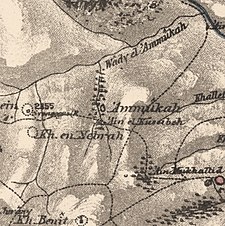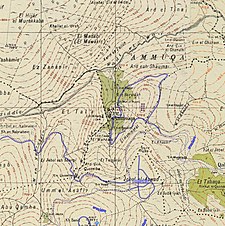This is an old revision of this page, as edited by EliasAntonakos (talk | contribs) at 14:55, 1 July 2024. The present address (URL) is a permanent link to this revision, which may differ significantly from the current revision.
Revision as of 14:55, 1 July 2024 by EliasAntonakos (talk | contribs)(diff) ← Previous revision | Latest revision (diff) | Newer revision → (diff) Village in Safad, Mandatory Palestine| Ammuqa عموقهAmuka, 'Amuqa | |
|---|---|
| Village | |
| Etymology: "deep" | |
 1870s map 1870s map
 1940s map 1940s map
 modern map modern map
 1940s with modern overlay map
A series of historical maps of the area around Ammuqa (click the buttons) 1940s with modern overlay map
A series of historical maps of the area around Ammuqa (click the buttons) | |
 | |
| Coordinates: 33°00′22″N 35°31′13″E / 33.00611°N 35.52028°E / 33.00611; 35.52028 | |
| Palestine grid | 198/267 |
| Geopolitical entity | Mandatory Palestine |
| Subdistrict | Safad |
| Date of depopulation | 24 May 1948 |
| Area | |
| • Total | 2,574 dunams (2.574 km or 636 acres) |
| Population | |
| • Total | 140 |
| Cause(s) of depopulation | Military assault by Yishuv forces |
| Current Localities | Amuka |
Ammuqa (also transliterated 'Amuqa and Amuka) was a Palestinian village, located five kilometres northeast of Safed.
In the late 19th century, Ammuqa was one of several villages settled by Algerian migrants under the auspices of the Ottoman Empire. The inhabitants belonged to the tribe of Awlad bu Alwarath, from Dellys, Algeria.
History
Known locally for its seven springs, Ammuqa also enjoyed renown as the site of the sepulchre of Jonathan ben Uzziel. Rabbi Samuel ben Samson, who travelled to Palestine in 1210, writes that the site was marked by "a great tree" where the local Muslim population made vows "to his glory" and gave votive offerings of oil and light.
Ottoman era
In 1517, Ammuqa was incorporated into the Ottoman Empire, and by 1596 tax-records it was under the administration of the nahiyah ("subdistrict") of Jira, part of Safad Sanjak, with a population of 65 households and 6 bachelors; an estimated 391 persons, all Muslim. They paid taxes on wheat, barley, olives, beehives, vineyards, and goats; a total revenue of 5,585 akçe. 1/12 of the revenue went to a Muslim charitable endowment.
In the second half of the 19th century Algerian followers of Abdelkader El Djezairi have been defeated by the French in Algeria, and sought refuge in another part of the Ottoman Empire. They were given lands in various locations in Ottoman Syria, including Ammuqa, and the close-by Dayshum, Marus, Al-Husayniyya and Tulayl.
British Mandate era
In the 1922 census of Palestine conducted by the British Mandate authorities, 'Amuqa had a population of 114, all Muslims, decreasing slightly in the 1931 census to 108, still all Muslims, in a total of 17 houses.
By the 1944/45 statistics, the village had a population of 140 Muslims with a total land area of 2,574 dunams. Of this, a total of 1,164 dunums of land was used for cereals; 195 dunums were irrigated or used for orchards, while 30 dunams were classified as built-up (or Urban) area.
1948, aftermath
During the 1948 Arab–Israeli War, on the 24 May 1948, Ammuqa was assaulted by the Palmach's First Battalion, headed by Yigal Allon. Following the "systematic" destruction of the villages in the Hula Valley, Ammuqa was evacuated.
In 1980 Amuka was established on village land; about 1 km southeast of the village site.
In 1992 the village site was described: "Nothing remains of the village but the rubble of houses; the site is overgrown with cactuses and eucalyptus, fig, and olive trees. Much of the land around the site is wooded, and some parts are cultivated by the settlement of 'Ammuqa".
See also
References
- Palmer, 1881, p. 66
- ^ Government of Palestine, Department of Statistics. Village Statistics, April, 1945, quoted in Hadawi, 1970, p. 69 Archived 2011-06-04 at the Wayback Machine.
- ^ Department of Statistics, 1945, p. 9
- Morris, 2004, p. xvi, village # 47. Also gives the cause of depopulation.
- ^ Khalidi, 1992, p. 434
- Ahmad Abbasi, Mustafa (2007). "הקהילה האלג'יראית בגליל משלהי השלטון העות'מני עד שנת 1948". אופקים בגיאוגרפיה. 68/9: 59–60.
- Adler, 2004, p. 107.
- Conder and Kitchener, 1881, SWP I, p. 205
- Conder and Kitchener, 1881, SWP I, p. 220
- Hütteroth and Abdulfattah, 1977, p.175, quoted in Khalidi, 1992, p.433.
- Note that Rhode, 1979, p. 6 Archived 2019-04-20 at the Wayback Machine writes that the register that Hütteroth and Abdulfattah studied was not from 1595/6, but from 1548/9
- Abbasi, 2007 (Hebrew). Non-Hebrew version in The Maghreb Review, 28(1), 2003 pp. 41-59.
- Guérin, 1880, pp. 439-440
- Barron, 1923, Table XI, Sub-district of Safad, p. 41
- Mills, 1932, p. 105
- Government of Palestine, Department of Statistics. Village Statistics, April, 1945. Quoted in Hadawi, 1970, p. 118 Archived 2015-09-24 at the Wayback Machine
- Government of Palestine, Department of Statistics. Village Statistics, April, 1945. Quoted in Hadawi, 1970, p. 168 Archived 2014-11-01 at the Wayback Machine
- "Welcome to Ammuqa". Palestine Remembered. Retrieved 2007-12-09.
- Morris, 2004, pp. 251–252.
Bibliography
- Abbasi, Mustafa (2007). "From Algeria to the Holy Land: Algerian communities in the Galilee, from the late Ottoman period to 1948 / הקהילה האלג'יראית בגליל משלהי השלטון העות'מני עד שנת 1948". Horizons in Geography / אופקים בגאוגרפיה (68/69): 56–72. ISSN 0334-3774. JSTOR 23716446.
- Adler, E.N. (2004). Jewish Travellers. Routledge. ISBN 0-415-34466-2.
- Barron, J. B., ed. (1923). Palestine: Report and General Abstracts of the Census of 1922. Government of Palestine.
- Conder, C.R.; Kitchener, H. H. (1881). The Survey of Western Palestine: Memoirs of the Topography, Orography, Hydrography, and Archaeology. Vol. 1. London: Committee of the Palestine Exploration Fund.
- Department of Statistics (1945). Village Statistics, April, 1945. Government of Palestine.
- Guérin, V. (1880). Description Géographique Historique et Archéologique de la Palestine (in French). Vol. 3: Galilee, pt. 2. Paris: L'Imprimerie Nationale.
- Hadawi, S. (1970). Village Statistics of 1945: A Classification of Land and Area ownership in Palestine. Palestine Liberation Organization Research Center. Archived from the original on 2018-12-08. Retrieved 2011-02-04.
- Hütteroth, Wolf-Dieter; Abdulfattah, Kamal (1977). Historical Geography of Palestine, Transjordan and Southern Syria in the Late 16th Century. Erlanger Geographische Arbeiten, Sonderband 5. Erlangen, Germany: Vorstand der Fränkischen Geographischen Gesellschaft. ISBN 3-920405-41-2.
- Khalidi, W. (1992). All That Remains:The Palestinian Villages Occupied and Depopulated by Israel in 1948. Washington D.C.: Institute for Palestine Studies. ISBN 0-88728-224-5.
- Mills, E., ed. (1932). Census of Palestine 1931. Population of Villages, Towns and Administrative Areas. Jerusalem: Government of Palestine.
- Morris, B. (2004). The Birth of the Palestinian Refugee Problem Revisited. Cambridge University Press. ISBN 978-0-521-00967-6.
- Palmer, E. H. (1881). The Survey of Western Palestine: Arabic and English Name Lists Collected During the Survey by Lieutenants Conder and Kitchener, R. E. Transliterated and Explained by E.H. Palmer. Committee of the Palestine Exploration Fund.
- Rhode, H. (1979). Administration and Population of the Sancak of Safed in the Sixteenth Century. Columbia University. Archived from the original on 2020-03-01. Retrieved 2017-11-02.
External links
- Welcome to Ammuqa
- 'Ammuqa, Zochrot
- Survey of Western Palestine, Map 4: IAA, Wikimedia commons
- 'Ammuqa, at Khalil Sakakini Cultural Center
- Ammuqa, Dr. Khalil Rizk.
